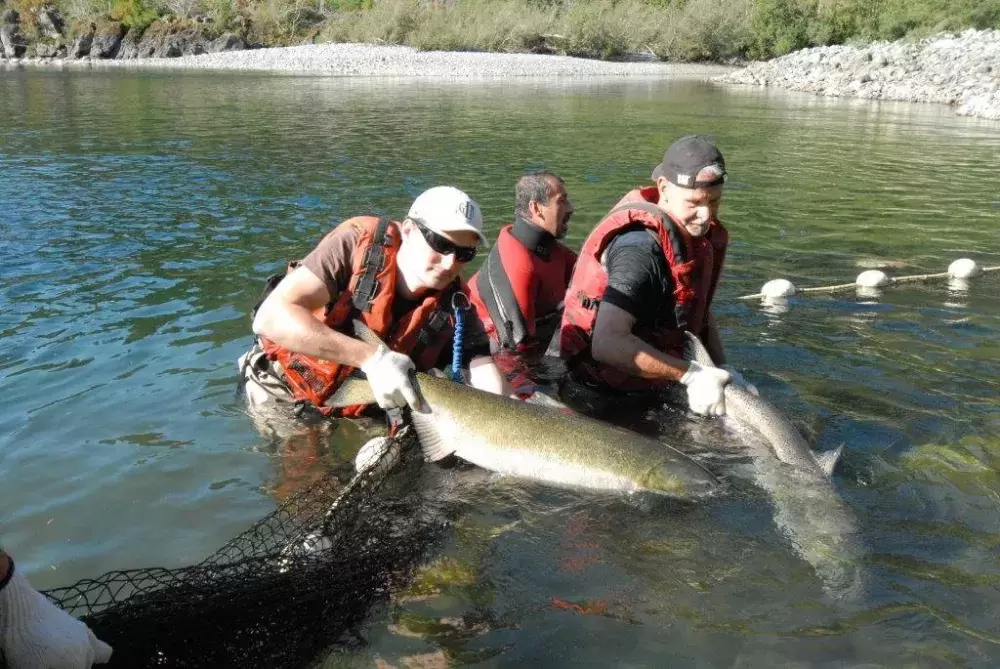Habitat restoration work to rebuild chinook productivity in North Island watersheds is “a drop in the bucket” but could become a stepping stone for long-term salmon sustainability, says a T’aaq-wihak biologist.
Local contractors are completing the first phase of a three-year project to remediate riparian habitat and monitor results along half a dozen salmon streams in the Nootka Sound region.
The project got underway last year in the Sucwoa (Tsax’hoa) River floodplain between Tahsis and Gold River, one of many coastal watersheds heavily damaged by past logging practices, said Roger Dunlop, northern region biologist. Nootka Sound Watershed Society (NSWS) obtained a $904,000 grant in 2019 from DFO’s Coastal Restoration Program.
Local First Nations — Mowachaht/Muchalaht, Ehattesaht and Nuchatlaht — along with NSWS maintain that the best way of restoring salmon productivity is to remediate habitat degradation caused by logging and related activities, such as roadbuilding. The Sucwoa watershed, lying within Mowachaht/Muchalaht territory, is part of Western Forest Products’ (WFP’s) Tree Farm Licence 19.
Enter NSWS, a grass-roots group formed in the late 1990s to protect, restore and enhance salmon in the Nootka Sound and Esperanza Inlet region. Society volunteers have worked together on numerous local projects since then, collaborating with DFO and forestry partners, including WFP.
“We are working with First Nations and stakeholders across Nootka Sound to achieve our common goal of enhancing fish habitat,” said Paul Kutz, WFP senior operations planner and a society board member.
For the riparian restoration project, NSWS hired Strategic Natural Resource Consultants to manage the project and Nootka Reforestation to provide labour, employing MMFN workers.
“We’re just completing the first year,” said Kent O’Neill, president of the society, which includes three Nuu-chah-nulth nations among its membership. A decade ago, WFP oversaw a study of the area to identify and prescribe restoration treatments for the Sucwoa floodplain, O’Neill explained.
“We’re taking that prescription and putting it into reality,” he said.
The Sucwoa, which drains into Head Bay on Tlupana Inlet, contains about 25 kilometres of fish-bearing habitat. Logging of the lower watershed began in 1958 and much of the floodplain and riparian or riverbank forest was harvested by the 1970s.
A lot of the more productive habitat was logged to the stream bank in those days, before regulations required “leave strips,” protective borders of riparian forest. By the 1990s, however, more than 40 per cent of forest in the Sucwoa watershed had been harvested. Removing the mature forest altered the hydrological processes within the watershed. Road development and sediment deposits have also undermined the river’s salmon productivity.
Beyond the Sucwoa, the NSWS project will evaluate and implement riparian treatments for Chum Creek, Little Zeballos River, Tahsis River, Leiner/Perry River and Tsowwin River by 2021.
Dunlop said the primary objective is to improve the stream channel and stabilize stream banks, partly by promoting conifer root growth hindered by understory species such as alder and salmonberry that flourished after logging.
“It not only benefits the chinook salmon, but it benefits all the fish and wildlife, which means it benefits people, too,” he said.
The Sucwoa also supports populations of coho, chum and pink as well as cutthroat trout.
A founding member of NSWS, Dunlop has extensive experience with stream restoration and wrote the grant application on the society’s behalf. By legislating greater protections in recent decades — essentially creating “no-take” zones for logging around streams — the provincial government has in effect “orphaned” damaged riparian areas, he said.
“It’s an incentive for us to go back in and do this,” he said. “The reason for doing riparian work is explicitly to improve bank cohesion and root strength … The one thing we could do is just get this wood growing along the banks, but other issues will remain. We have not yet addressed the necessary allowable cut reductions to address the related hydrology or chronic sedimentation problems.”
Conifers take hundreds of years to mature, die and fall, perpetuating the life cycle that produces large woody debris vital to chinook salmon habitat. Consequently, it could be many generations before habitat productivity is fully recovered. Restoration efforts, however, are a step in the right direction.
“We’re using the money as strategically as we can,” Dunlop said.
He views the current project as complimentary, an incremental step towards a more “global” approach that could improve long-term sustainability of salmonids. That’s where so-called salmon parks come in, the idea of protecting whole watersheds from logging, a concept rooted in the Nuu-chah-nulth principle of hishukish tsa’walk — everything is interconnected. Last year, the Ha’wiih of Nuu-chah-nulth nations proposed that the provincial government use its authority to designate a system of salmon parks. NSWS is equally committed to the idea.
“We’ve been pushing hard for salmon parks,” O’Neill said.
Meanwhile, logging continues at higher elevations in the Sucwoa watershed, ensuring that counter-productive hydrological processes continue. The nations have been calling for a reduced rate of harvest in support of stream rehabilitation.
“Nootka Sound has 40 salmon streams and I can’t think of one that hasn’t been logged,” Dunlop said.







